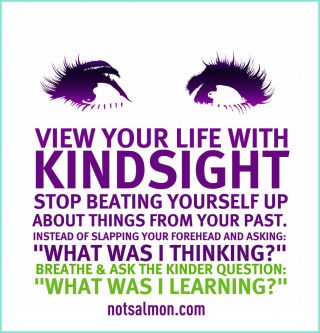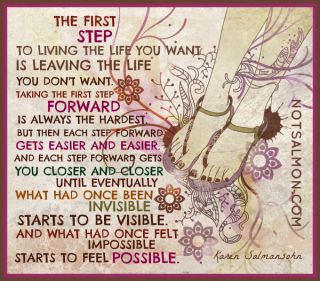
Career
Can Posters Work As Pattern Interrupts In Changing Moods?
Why Facebook, Pinterest and Instagram are full inspirational posters
Posted July 17, 2012

About two years ago, I gave birth to a baby boy. Shortly after, I found myself experiencing trouble giving birth to writing a book. I began believing in that much talked—about "mommy brain."
Thankfully, I've always loved design. Being the positive problem solver that I am, I started experimenting with designing inspiring posters. It seems the "designer" part of my brain was not fogged by newbie mommyhood. (Perhaps this is a topic for yet another essay — where I explore the interesting workings of the right versus left brain! I know in the book My Stroke of Insight, the author said she found it easier to write in a journal rather than by computer when she was on her way to recovery. But I digress!)
I began calling my daily posters I was writing and designing my "Daily Inspirational Flashcards" — because their goal was to quickly remind people of the positive psychological beliefs and productive habits which lead to the happiest life. Soon, my "Inspirational Flashcards" began to go viral — with thousands — then hundreds of thousands — then even millions of shares for a single poster. I began receiving hundreds of emails from people — thanking me — explaining that my daily "Inspirational Flashcards" were truly helping them battle depressed emotional states — even when it came to dealing with majorly challenging issues like a bipolar disorder or a loved one's death.
I wondered:

I wondered:
I discussed it with friends who also write psychologically oriented books. We all came to the same conclusion. My "Inspirational Flashcards" create what’s called “A Pattern Interrupt” — a psychological tool, recommended by practitioners of Neural Linguistic Programming, to help stop limiting beliefs.
If you saw the movie Shallow Hal, then you saw a Pattern Interrupt in action in that elevator scene — albeit a humorously re—enacted example of a Pattern Interrupt.
If you haven’t seen Shallow Hal, here’s a quickie synopsis: Tony and Jack get trapped in an elevator, and begin to talk about dating. Tony speedily discovers that Jack’s character engages in a limited thought pattern — stubbornly only dating stunning women for shallow reasons. Tony helps Jack to break his superficial thought pattern by surprising Jack with a clunk on his head — then shouting “Devils come out!” Sure enough, instantly a new mental window opens for Jack. He is now able to think about dating with a less shallow lens.
Other known methods for Pattern Interrupts have included: snapping a rubber band on your wrist, playing powerful music, being hit with unexpected comic relief, doing calming meditations, repeating positive affirmations — and reading an inspirational poster on Facebook! All these various Pattern Interrupts work like a “Thought Intervention” — creating a jiggling affect upon a person’s tightly held negative beliefs — then jumpstarting a new positive pattern of thought.
A Pattern Interrupt works in real life like this:

A Pattern Interrupt works in real life like this:
There’s a famous Albert Einstein quote: "We can't solve problems by using the same kind of thinking we used when we created them." Well, Albert’s philosophy is a good explanation for why a Pattern Interrupt can snap you out of a negative thought loop. A Pattern Interrupt literally changes your brain’s energy state.
Here’s the neuroscientific scoop: MRI’s of the brain show that every time a person thinks angry thoughts or imagines worst-case scenarios, they literally send a surge of blood flowing into brain regions associated with depression and anger (the right prefrontal cortex) — thereby refueling depression and anger. Happily, MRI’s have also shown that when a person starts to think happy thoughts, they can send a surge of blood flowing into brain regions associated with happiness (the left prefrontal cortex) — thereby literally refueling your positivity.

Plus, recent studies on learning show that when you incorporate visuals into your learning process, you can better “record” a message into your permanent memory bank.
More of the neuroscientific scoop: When you put words within pictures, your brain immediately perks up in an effort to make sense of how/why these words relate to the picture — thereby stimulating more neuron activity. The more neurons you have firing up, the greater the chance that your brain is paying attention and recording what it is perceiving. This is why using flashcards with pictures help people to learn info better! Similarly, positivity—pushing posters jackhammer drill home positive messaging in a stronger way than words alone.

In the last year, I've noticed a trend on Facebook of hundreds of other "Pages" offering positively inspiring posters. It's really taken off as a wildly popular activity — for people to read, share and tag positive posters! During this same year's time, Pinterest and Instagram have also wildly grown in their usership — both of which are also huge aggregates for happiness—boosting posters. I believe this is not merely a trend for the self help world. I believe this is a new medium for self help — one which is here to stay.
After all, in today's uber-busy, espresso-chugging, hyper-active world, it’s often hard to find time to read an inspirational self help book — but — you can always find time to read an inspirational poster.
Karen Salmansohn is a best selling author and designer - wiht over a million books sold - known for creating self help for people who wouldn't be caught dead doing self help -and founder of www.notsalmon.com a popular website for inspiration. Click here to check out her Facebook page, and explore if posters are an empowering mood booster for you.
Plus... Her new book INSTANT HAPPY is due out in October from Random House - which offers up a collection of her popular viral posters.



